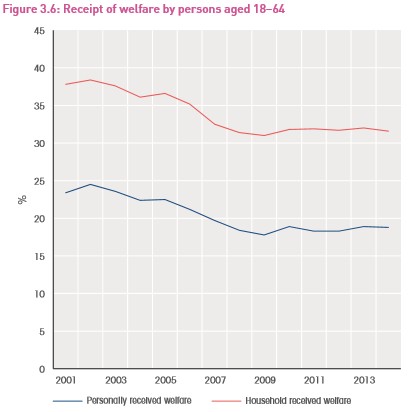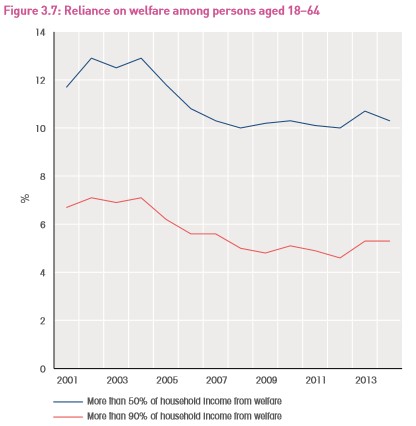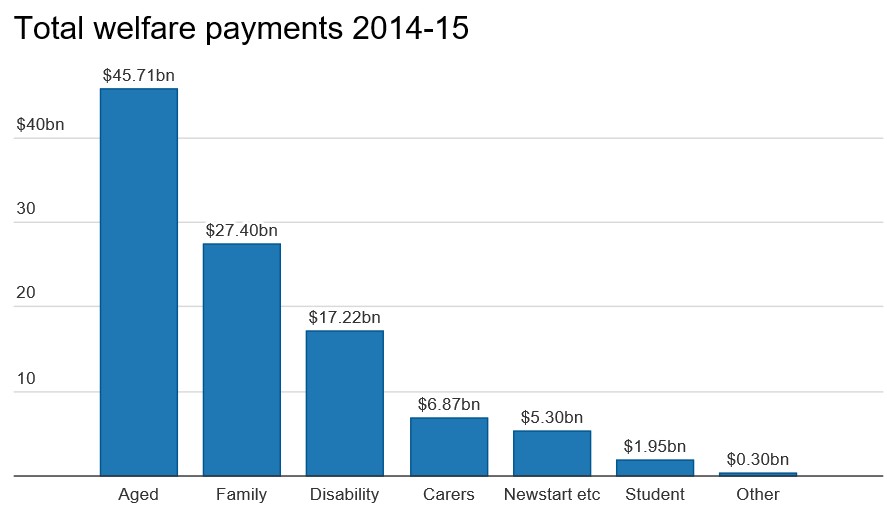Treasurer Scott Morrison took his war against the unemployed to another level over the weekend, vowing to end the “welfare creep” that encourages thousands of Australians to avoid getting a job. From The Australian:
The Australian yesterday revealed that 43,200 welfare recipients were getting more than they could if they worked at the average wage…
The government stood by the analysis that shows at least 43,200 people received at least $45,032 tax-free last financial year from the single-parent payment, childcare rebates and family tax payments.
The combined amount is greater than the after-tax income for workers (including full-time and part-time) on the median wage, who take home $39,841.
“It is a crying shame that some Australians would have to take a pay cut to get a job in this country because of the way our welfare system works,” Mr Morrison said.
“The welfare system has crept and crept and crept, and it’s important that governments actually attend themselves to that and stop the welfare creep that is occurring right across our community.”
The analysis was ridiculed by Greg Jericho over at The Guardian:
To support the need for welfare cuts to prevent this supposedly unjust situation, an example was provided of a person who despite not working would receive $52,523 from various government payments – an amount more than the $39,841 take-home pay of the median worker or even the $49,831 brought home by the median full-time worker.
As Kurtz would say, “The horror! The horror!”
Well no, actually.
Who is this shocking example that should have us gnashing our teeth over the bloated, bludger-inducing welfare system?
Why, a single parent with four children aged four, seven, 10 and 13 who neither receives any employment income, nor any child support from (presumably) the father, and who is paying $400 a week in rent.
…it is patently absurd to hold up such a family as an example of anything, let alone the welfare system… Ben Phillips, from the ANU’s centre for social research and methods, estimates that only 4% of single parents have four or more kids and only about 2.5% are in a situation where their income would be such that they would be eligible for all the income this hypothetical person is getting…
Never in the history of the world has being a single mother with four kids been considered a ticket to easy street.
Other experts also ridiculed the analysis, via The SMH:
Former Department of Social Security analyst David Plunkett said the calculation excluded $30,916 in family tax benefits that the parent working full-time would also receive, meaning that when “apples are compared with apples”, the parent would receive $80,747 if working and $52,523 per year if not working.
The parent would be almost $30,000 per year better off working than not working, rather than than $2692 worse off as claimed…
Peter Davidson, research director at ACOSS, said the “glaring omission” was remarkable because family tax benefits were the biggest source of income for the non-working parent. To have cited them as income while not working, but not while working biased the calculation by $30,000.
It also failed to build the case for government plans to scale back family tax benefits, because if those plans were approved by the Senate and legislated the differential would be unchanged.
I will simply add that the recently released HILDA survey showed that welfare reliance for those at working age age has actually fallen over the past decade:


Analysis from the Parliamentary Library and data from NATSEM has drawn similar conclusions showing that the proportion of the working-aged population claiming income support has declined from a peak of 25% in 1994 to 16.6%.
Still, the Coalition has found support in Pauline Hanson, who has backed welfare cuts. From The AFR:
In an exclusive interview with AFR Weekend, Senator Hanson indicated One Nation would take a hard line in support of budget repair.
“Right across the board, not only in welfare, I see a big waste of money and we actually have to rein it back in.”
She said successive governments, in a bid to win votes, had allowed welfare to become a way of life rather than a helping hand and “tough decisions” were needed.
“If we are going to be able to, in the future, support those who are truly in need, like the sick or the aged, we’ve got to do something about it now,” she said.
Ms Hanson’s hard line on welfare is curious given she is very generous towards seniors’ welfare.
Back in July, Hanson vowed to oppose the Turnbull Government’s superannuation reforms, claiming that the Government should cut spending rather than unwinding superannuation concessions. From The Australian:
“Superannuation, I don’t believe in the government’s policy. Leave the superannuation alone”…
“You should be encouraging people to save, put the money away; you can’t keep changing the goalposts every couple of years. People want to know that it’s there, they know what to do for their future.
“It’s not the way to go and they reckon they’re going to pull in some money. There’s other areas that they can actually control the spending.”
One Nation’s policy platform also sought to raise the Aged Pension by $100 per fortnight for a single aged pensioner and by $150 for a couple, as well as opposing a tighter assets test:
One Nation’s policies on aged pensions:
• We propose an increase of $100 per fortnight for a single aged pensioner and $150 for a couple.
• We do not support increasing the age of entitlement to 70 years of age.
• We will oppose the family home as part of the asset test.
• Review the entitlement of people with more than 5 acres receiving the aged pension and health benefits.One Nation believes in supporting and taking care of our own, who have contributed to this great nation and not those who land uninvited on our doorstep and immediately receive medical, welfare, housing, phones, and cigarettes.
Now let’s review where Australia’s welfare dollars are flowing:

That’s right, the biggest and fastest growing component – the Aged Pension ($45.7 billion currently rising by $2 billion per year to $52 billion by 2019-20) – dwarfs the other forms of welfare expenditure.
The Aged Pension is also the most poorly targeted because the family home is largely excluded from the assets test. Therefore, there are hoards of wealthy pensioners receiving taxpayer assistance (see here for detailed examination).
Given that Ms Hanson supports tighter restrictions on working Australians receiving welfare, but an increase in old age pensions and no changes to Australia’s ridiculously generous and inequitable superannuation concessions, we can only assume that she wants younger Australians to bear the full burden of expenditure cuts and Budget repair.

